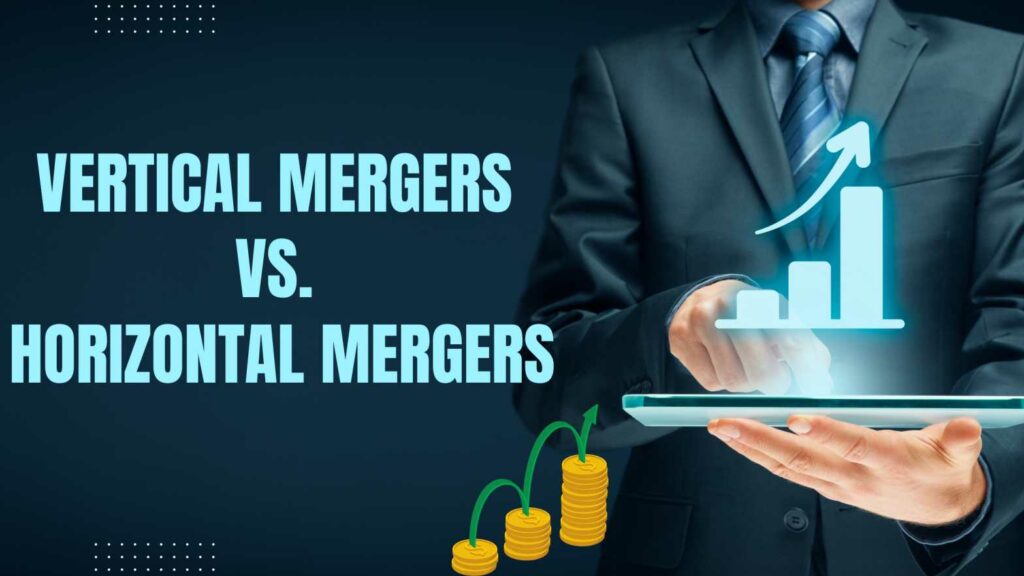Last updated on July 2nd, 2024 at 02:26 pm
Mergers and acquisitions are widely utilised by organisations to improve market share, efficiency, and, eventually, profitability. In this blog, we'll look at the key juxtaposes between these two techniques, understanding their unique qualities and ramifications.
When two firms at different stages of the supply chain join forces, a vertical merger occurs. This indicates that an organisation either acquires a supplier, a customer, or both.
A horizontal merger, on the other hand, includes the merging of two firms that operate in the same industry and at the same stage of the supply chain. Assume two competing smartphone makers joining together; this is an example of a horizontal merger.
If you want to have a career in investment banking or a career in banking and finance, delve into understanding the difference between vertical and horizontal mergers and how it is crucial when one takes up an investment banker course.
Vertical Mergers vs. Horizontal Mergers: Definitions
A vertical merger involves two companies operating at different levels of the supply chain or manufacturing process. A corporation integrates with another organisation either up or down the supply chain hierarchy. This implies that the merger might include the purchase of a supplier, a customer, or a firm in a separate but similar industry.
A vertical merger's objective is to improve operational efficiency, reduce expenses, and gain greater autonomy over the manufacturing or distribution process. The merging firm obtains synergies and optimises its operations by joining forces with a business entity at a different level of the supply chain. For example, by acquiring a textile mill, a clothesmaker may ensure a steady supply of raw materials, lowering manufacturing costs.
A horizontal merger includes the merging of two firms operating in the same industry and at the same phase of the supply chain. The primary rationale for horizontal mergers is to gain market strength and competitiveness. For example, if two telecommunications businesses join, they may be able to offer a broader choice of services, decrease infrastructure duplication, and improve their market competitiveness.
Understanding the differences between vertical and horizontal mergers proves essential for companies, investors, and regulatory agencies. These two types of mergers have distinct ramifications for market dynamics, competition, and consumer welfare, making them a subject of acute interest and scrutiny in the business community.
Vertical Merger vs. Horizontal Merger
| Aspect | Vertical Mergers | Horizontal Mergers |
| Definition | Integrates companies from different stages of the supply chain or production process. | Integrates companies operating within the same industry and supply chain stage. |
| Supply Chain Impact | Extends vertically along the supply chain; either upstream or downstream. | Stagnant in the same stage of the supply chain. |
| Competitive Advantage | Enhances control of the supply chain resulting in cost efficiency and reduced dependency on external stakeholders. | Improves market presence and reduces competition. |
| Risks and Challenges | Potential integration can lead to complexities and challenges while realising cost savings. | Integrates corporate culture, market dominance concerns and antitrust issues. |
| Regulatory Scrutiny | Scrutinised by antitrust authorities. | Faces scrutiny due to reduced competition. |
The above table would help you to understand vertical and horizontal mergers if you are seeking an investment banking certification or a banking and finance course.
Case Study of Vertical Mergers and Horizontal Mergers
If one is looking to take up an investment banking course, it is pivotal to understand the juxtaposition of vertical and horizontal mergers case studies. They are:
Adobe and Figma
Adobe purchased Figma, a renowned web-first collaborative design tool, in September 2022. The merger of the two companies will, according to Adobe, "usher in a new era of collaborative creativity.”
Figma's objective at the time of the merger was to pioneer web-based product design solutions. Though Adobe dealt with the digital experiences industry, its business was somewhat different. Figma was created specifically for online and app design, whereas Photoshop could only create prototypes of them. Adobe got access to a previously unreachable market by joining enterprises.
TD Bank and First Horizon
Microsoft announced the acquisition of Activision Blizzard in January 2022. Microsoft already had the popular Xbox brand; the acquisition enabled Microsoft to provide great, unique content to video gamers and reap the benefits of doing so.
Satya Nadella announced that Microsoft was investing in Activision Blizzard "to usher in a new era of gaming that puts player and creators first and makes gaming safe, inclusive, and accessible for all." The agreement would strengthen Microsoft's Game Pass portfolio by giving subscribers more broad and robust content. It should be noted that the transaction has yet to receive FTC approval as of July 2023.
Drawbacks of Vertical Mergers and Horizontal Mergers
While vertical and horizontal mergers entail potential benefits, they also have costs and obstacles.
Drawbacks of Vertical Mergers:
Complex Integration: Vertical mergers require integrating businesses with diverse operating procedures and cultures, which can provide integration issues. Coordination of various phases of the supply chain can be logistically challenging.
Reduced Supplier/Customer Choice: Vertical integration can limit suppliers' or customers' alternatives, hence diminishing competition. This may raise concerns about market domination and antitrust violations.
Cost Risks: Vertical mergers are intended to lower costs via efficiency, but they can sometimes result in unforeseen expenses, such as those involved with merging different IT systems or settling contractual commitments with current suppliers or customers.
Loss of Focus: Companies that engage in vertical mergers distract their attention away from their key capabilities, which have a detrimental influence on their overall success in their primary markets.
Drawbacks of Horizontal Mergers:
Reduced Competition: Horizontal mergers often result in the elimination of market rivals, resulting in decreased competition. This results in higher consumer pricing and less innovation.
Integration Difficulties: Integrating two firms in the same market can be difficult. Disruptions and morale concerns can result from cultural conflicts, unnecessary activities, and employee cutbacks.
Regulation: Because of their potential to produce monopolistic or oligopolistic market structures, horizontal mergers often receive more attention from antitrust authorities. Obtaining regulatory permission may be a lengthy and unpredictable procedure.
Market Concentration: When market power is concentrated in the hands of a few dominant businesses, it hinders innovation and limits customer options, possibly damaging market dynamics and overall economic well-being.
Conclusion
Vertical mergers are concerned with supply chain efficiency and lowering costs and horizontal mergers are concerned with increasing market share and consolidating market dominance within the same industry. The decision between these mergers and acquisitions techniques is determined by a company's strategic goals, regulatory concerns, and capacity to negotiate the unique hurdles associated with each approach.
If you are looking for investment banking courses online, check out Imarticus Learning's Certified Investment Banking Operations Professional or CIBOP course. This investment banker course would provide you with 100% job assurance and build your career.
To know more, check out the website right away.












